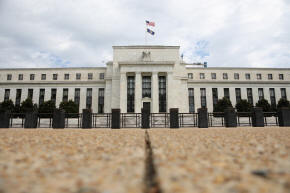Analysis-Loosening financial conditions threaten central
bank inflation fight
 Send a link to a friend
Send a link to a friend
 [August 16, 2022] By
Yoruk Bahceli [August 16, 2022] By
Yoruk Bahceli
(Reuters) - The U.S. Federal Reserve is
hiking interest rates at the most aggressive pace in a generation, but
the financial conditions it needs to tighten to tame soaring inflation
are heading in the wrong direction.
A rally in equities and falling government bond yields since the Fed's
June hike means financial conditions are actually loosening, despite the
U.S. economy having been hit with a combined 150 basis points of rate
hikes at that meeting and the next one.
Financial conditions reflect the availability of funding in an economy.
They dictate spending, saving and investment plans of businesses and
households, so central banks want them to tighten to help control
inflation, which is now running far above their target levels.
A widely followed U.S. financial conditions index (FCI) compiled by
Goldman Sachs, which factors in borrowing costs, equity levels and
exchange rates, has loosened some 80 basis points (bps) since the Fed's
June meeting.
A similar index from the Chicago Federal Reserve, which tracks financial
conditions independent of prevailing economic conditions, has turned
negative, implying conditions are loose relative to what the current
economic picture would usually suggest.

In the euro zone, conditions have also loosened by about 40 basis
points, according to Goldman Sachs, and money markets have priced out
most of the 2023 rate hikes they had previously expected.
"Back in June we thought that (U.S.) financial conditions were broadly
where they should be to engineer the slowdown that you need to bring
activity, wage growth and price inflation back to target," said Daan
Struyven, senior global economist at Goldman Sachs.
"Our best guess is that they've eased a little too much."
Graphic: U.S. financial conditions loosen -
https://fingfx.thomsonreuters.com/
gfx/mkt/movangyzqpa/1BS0o-u-s-financial-conditions-loosen-significantly-after-june-hike.png
The change in conditions has been driven by recession fears, which have
prompted markets to not only reduce how far they expect the Fed to hike,
but also to price in rate cuts next year. This suggests investors think
the Fed will be more concerned by a slowing economy rather than
inflation next year.
Fed Chairman Jerome Powell's comments following the bank's July rate
hike were also interpreted by some investors as implying a "dovish
pivot".
Money markets now expect Fed hikes to stop at around 3.6% next March,
compared with the 4%-plus expected before the June hike, followed by
some 50 bps of cuts by the end of 2023.
Since the June hike, the S&P 500 has gained 13%, oil prices are down 22%
and 10-year U.S. Treasury yields have fallen 70 bps. Credit markets have
also rallied.
To be sure, financial conditions are still some 200 bps tighter than
late 2021's record low, and stocks remain 10% down for 2022.
Goldman estimates a 100 bps tightening in its FCI will crimp economic
growth by one percentage point in the coming year.

[to top of second column] |

The Federal Reserve building is pictured
in Washington, DC, U.S., August 22, 2018. REUTERS/Chris Wattie

But the recent loosening is approaching what the bank terms an "FCI
loop", Struyven said.
"If you see very significant additional financial conditions easing that
would probably not be sustainable because the outlook for activity, wage
growth and inflation would look too hot."
UNFINISHED JOB
That risk is already reflected in market gauges of long-term inflation
expectations.
The 10-year U.S. breakeven rate has risen some 15 bps to 2.44% since
early July. Euro zone expectations have risen too.
"That dovish interpretation was the reason why inflation expectations
were driven up again. This just goes to show that the Fed still has an
unfinished job ahead of itself," said Patrick Saner, head of macro
strategy at Swiss Re.
Data last week showing U.S. inflation unchanged in July instead of
rising fuelled a further loosening in financial conditions.
But recent U.S. jobs and wage growth data point to increasingly tight
labour markets.
Economists note the U.S. unemployment rate, at 3.5%, is far lower than
the lowest level -- 4.4% according to the Congressional Budget Office --
it can reach without boosting inflation.
Annual wage growth of 5.2% is way above the 3.5% Goldman estimates is
necessary to pull inflation down to the Fed's target of 2%.
PUSHING BACK
Several Fed policymakers have pushed back against the shift in market
pricing, emphasising determination to keep tightening policy until price
pressures abate.
They also say that it is unlikely that the Fed will pivot to cutting
rates in 2023. A pricing out of those cuts would tighten financial
conditions.
Financial conditions need to tighten more and for that to happen, "you
either need to see some declines in risk assets, equity prices or
increases in longer-dated yields. Typically it's a combination," Saner
said.

Goldman Sachs expects 10-year U.S. Treasury yields to reach 3.30% by
year-end, up from today's 2.80%.
Others are sceptical of current equity valuations. Morgan Stanley
expects the S&P 500 to fall some 9% by June next year.
UBS analysts note that the stock market currently is consistent with
core inflation returning to 1.5%-2%. If it ends up a percentage point
higher, valuation adjustments imply a 25% drop in the S&P 500, they
estimate.
"Wishful thinking in markets only makes the job harder, by loosening
financial conditions and requiring more monetary tightening to
compensate," Bill Dudley, former head of the New York Fed, warned in an
opinion piece for Bloomberg News earlier in August.
(Reporting by Yoruk Bahceli, additional reporting by Samuel Indyk;
Editing by Tommy Reggiori Wilkes and Hugh Lawson)
[© 2022 Thomson Reuters. All rights
reserved.]
This material may not be published,
broadcast, rewritten or redistributed.
Thompson Reuters is solely responsible for this content. |